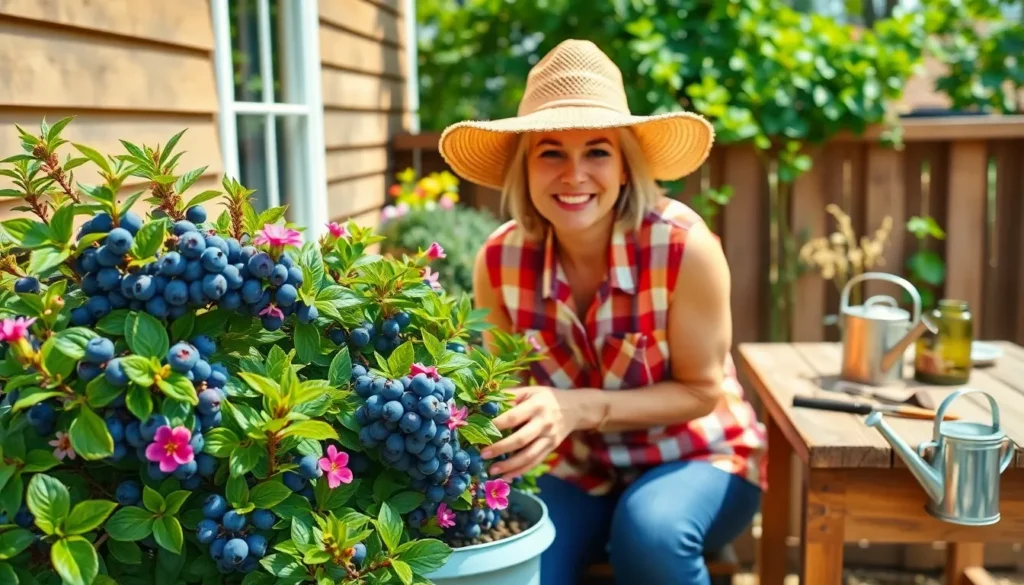Growing blueberries doesn’t require a sprawling backyard or perfect soil conditions. We’ve discovered that container gardening opens up incredible possibilities for cultivating these antioxidant-packed berries right on your patio, balcony, or even indoors near a sunny window.
Potted blueberry plants offer remarkable advantages over traditional ground planting. They give us complete control over soil conditions, drainage, and placement while protecting our precious plants from common garden pests and diseases. Plus, we can easily move containers to optimize sunlight exposure throughout the seasons.
Whether you’re a beginner gardener or someone with limited outdoor space, we’ll show you exactly how to transform any small area into a productive blueberry haven. The satisfaction of harvesting your own fresh, organic blueberries just steps from your kitchen is absolutely worth the effort – and it’s easier than you might think.
Choose the Right Blueberry Variety for Container Growing
Selecting the perfect blueberry variety transforms your container gardening success from challenging to rewarding. We’ll explore the best options that thrive in pots while delivering abundant harvests.
Dwarf and Compact Cultivars
Dwarf blueberry varieties make container growing effortless with their naturally compact growth habits. These varieties typically reach 2-4 feet in height, making them perfect for patios, balconies, and small gardens.
Top Shelf produces large, sweet berries on plants that stay under 2 feet tall. This variety delivers exceptional flavor while requiring minimal space and maintenance.
Sunshine Blue thrives in containers with its compact 3-foot mature height. We recommend this variety for warmer climates since it tolerates heat better than traditional blueberries.
Northsky handles cold temperatures exceptionally well while maintaining a 1-2 foot height. This hardy variety produces small but intensely flavored berries perfect for fresh eating.
Patriot combines disease resistance with moderate 4-foot growth, making it ideal for larger containers. Container gardeners appreciate its consistent berry production and adaptability to various growing conditions.
Self-Pollinating vs Cross-Pollinating Varieties
Self-pollinating blueberries eliminate the need for multiple plants, making them perfect for container gardeners with limited space. These varieties produce fruit independently, though berry yields often improve with cross-pollination.
Cross-pollinating varieties require two different cultivars to produce optimal fruit sets. We suggest planting at least two different varieties in separate containers to maximize berry production and size.
Benefit comparison shows self-pollinating varieties offer convenience while cross-pollinating combinations deliver larger harvests. Container gardeners with space constraints should choose self-pollinating options like Sunshine Blue or Top Shelf.
Pollination timing matters when selecting multiple varieties for cross-pollination. Choose varieties that bloom simultaneously to ensure successful pollination and fruit development.
Climate Zone Considerations
Northern highbush blueberries (zones 3-7) require 400-800 chill hours and handle freezing temperatures exceptionally well. These varieties include Patriot, Northsky, and Blueray.
Southern highbush varieties (zones 7-10) need fewer chill hours and tolerate heat better than northern types. Sunshine Blue, Misty, and Sharpblue thrive in warmer container environments.
Lowbush blueberries (zones 2-6) stay extremely compact at 6-24 inches tall, making them perfect for small containers. These varieties handle harsh winters but produce smaller berries with intense flavor.
Container protection becomes crucial in zones with temperature extremes. We recommend moving containers to protected areas during severe weather or wrapping pots with insulation materials.
Microclimate creation allows container gardeners to grow varieties outside their natural zones. Containers provide mobility to chase optimal growing conditions throughout the seasons.
Select the Perfect Pot Size and Material
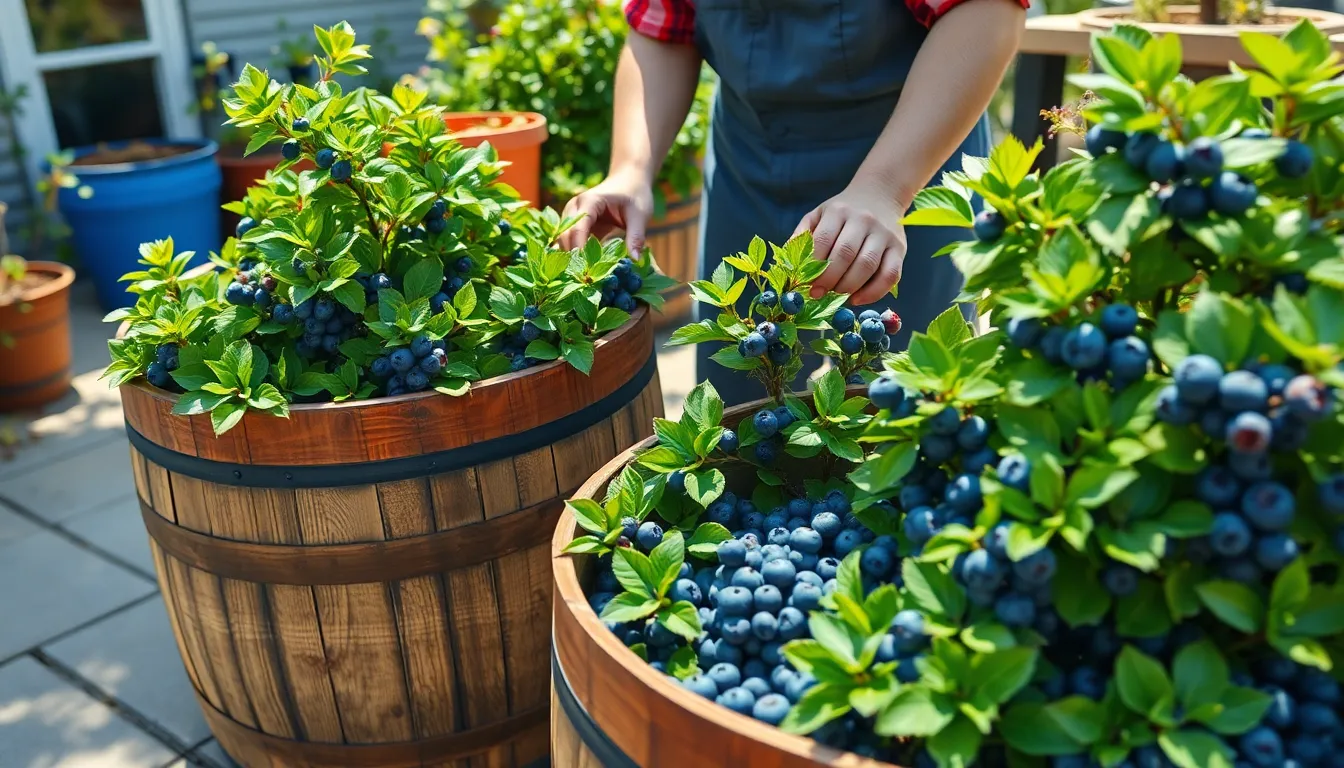
Choosing the right container for your blueberry plants determines their long term success and berry production. We’ll guide you through the essential requirements for optimal container selection.
Minimum Container Dimensions
Mature blueberry plants need containers that are at least 24 inches deep and 24 to 30 inches wide to accommodate their root system properly. For smaller plants or compact varieties, we can use containers with a minimum depth of 18 inches and width of 18 to 20 inches depending on the shrub size.
Root development directly impacts fruit production, so providing adequate space ensures healthy growth and maximum harvest yields. Container dimensions should match the expected mature size of your chosen blueberry variety to prevent root binding over time.
Drainage Requirements
Blueberry plants are extremely sensitive to waterlogged soil and require containers with ample drainage holes to prevent root rot. We recommend placing pots on bricks or elevating them slightly to improve water flow and prevent standing water accumulation.
Frequent light watering combined with occasional deep watering maintains optimal moisture levels without creating soggy conditions. This watering approach prevents the dreaded “wet feet” condition that can kill blueberry plants quickly.
Proper drainage becomes even more critical during rainy seasons when excess water can accumulate rapidly in containers.
Best Materials for Blueberry Containers
Black containers should be avoided because they absorb excessive heat, accelerating moisture loss and stressing blueberry plants. Wooden half barrels and other porous containers provide better air circulation and moisture regulation for optimal plant health.
We can bury containers partially in the ground to reduce heat stress and moisture loss while providing natural insulation during colder months. This technique helps maintain consistent soil temperatures throughout seasonal changes.
Container material affects both water retention and temperature control, making material selection as important as size considerations for successful blueberry cultivation.
Prepare the Ideal Soil Mix for Blueberry Plants in Pots
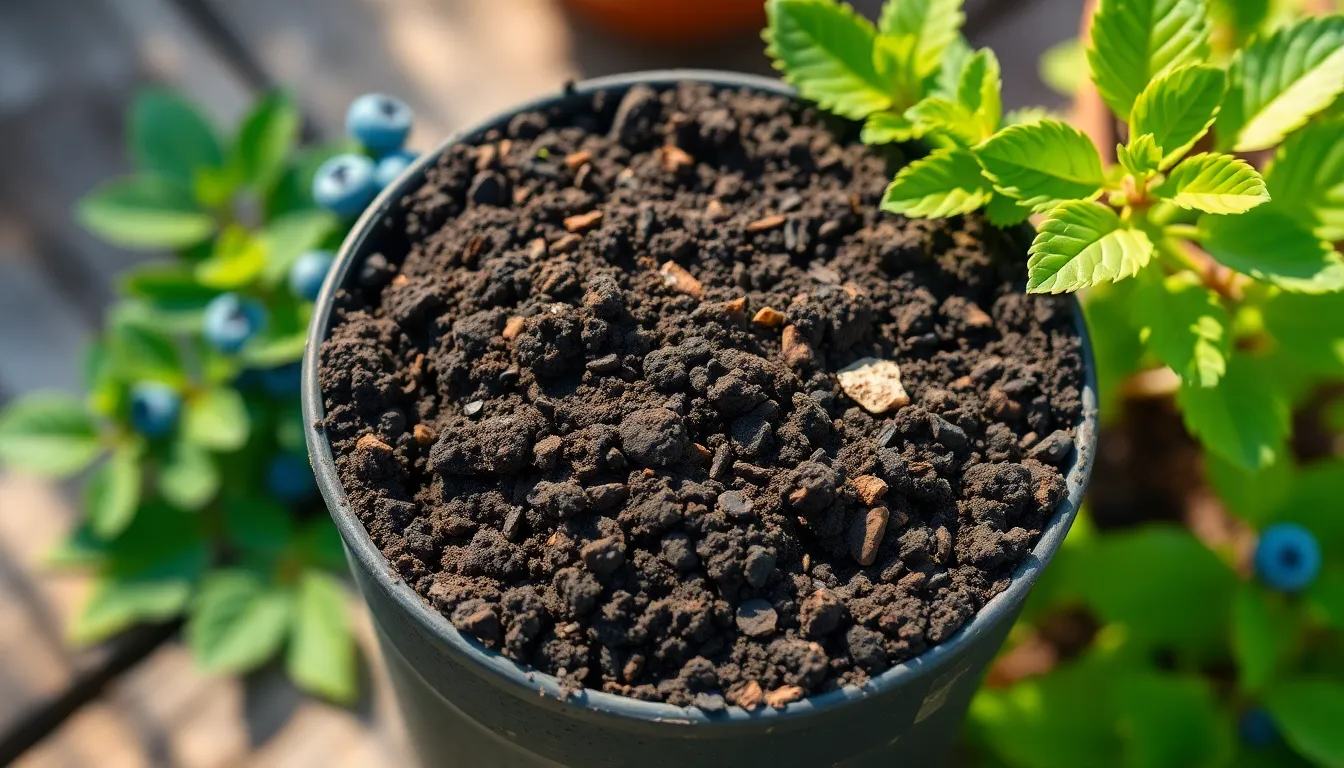
Creating the right soil environment sets the foundation for thriving blueberry plants in containers. We’ll explore the essential components that make up the perfect growing medium for these acid-loving plants.
Acidic Soil pH Requirements
Blueberries demand highly acidic soil conditions to access essential nutrients effectively. Our container plants need soil with a pH between 4.5 and 5.5 to flourish and produce abundant fruit. This acidic environment allows the plants to absorb iron, manganese, and other critical nutrients that become unavailable in neutral or alkaline conditions.
Testing soil pH regularly ensures we maintain optimal growing conditions throughout the growing season. Most standard potting soils are too alkaline for blueberries, making it crucial to either purchase specialized acidic mixes or create our own. Without proper pH levels, even the healthiest-looking plants may struggle with nutrient deficiencies and poor fruit production.
Organic Matter and Drainage Components
Peat moss serves as the cornerstone ingredient for blueberry container soil, providing both acidity and moisture retention. Pine bark adds structure to the mix while contributing additional acidic properties that blueberries crave. These organic components create an environment that mimics the natural forest floor conditions where wild blueberries thrive.
Drainage becomes critical since blueberries can’t tolerate waterlogged roots but also suffer when soil dries out completely. We achieve this balance by incorporating materials like perlite or coarse sand that allow excess water to drain while maintaining consistent moisture levels. The organic components decompose over time, requiring us to refresh or replace the soil mix periodically to prevent root stress and disease issues.
Mulching the soil surface with pine bark or hardwood bark conserves moisture and maintains the acidic environment our plants need. This protective layer also helps regulate soil temperature and suppresses weed growth in our containers.
Commercial vs Homemade Potting Mixes
| Mix Type | Advantages | Considerations |
|---|---|---|
| Commercial | Pre-adjusted pH, convenient, consistent quality | Higher cost, variable quality between brands |
| Homemade | Cost-effective, precise ingredient control | Requires pH monitoring, time-intensive preparation |
Commercial blueberry potting mixes offer convenience with their pre-balanced pH levels and proven ingredient combinations. These specialized mixes typically combine peat moss and pine bark in optimal ratios, saving us time and guesswork. Quality varies between manufacturers, so we recommend checking product reviews and ingredient lists before purchasing.
Homemade soil mixes give us complete control over ingredients and often cost less than commercial alternatives. A basic recipe combines equal parts peat moss and pine bark with a small amount of perlite for drainage. We must test and adjust pH levels regularly when creating our own mixes, as ingredient acidity can vary between sources.
Both approaches can produce excellent results when we maintain proper pH levels and ensure adequate drainage throughout the growing season.
Plant Your Blueberry Bush Properly

Once you’ve selected your container and prepared your acidic soil mix, the actual planting process requires careful attention to detail. Getting these transplanting steps right ensures your blueberry bush establishes strong roots and thrives in its new home.
Transplanting Techniques
Gently remove your blueberry plant from its nursery container by turning it upside down and supporting the root ball. We recommend tapping the bottom of the pot if the plant doesn’t slide out easily rather than pulling on the stem. After removing the plant, lightly roughen the outer surface of the root ball using a hand pruner or your fingers. This technique encourages new root growth and helps prevent the roots from continuing to grow in a circular pattern. Container grown plants often develop tightly wound roots that need this gentle disruption to spread outward into their new soil environment.
Root Ball Preparation
Roughening the root ball surface prevents roots from circling inside the pot and promotes healthy outward root development. We find that gently scoring the sides of the root ball with vertical cuts about half an inch deep works best for encouraging new growth. Focus on the bottom and sides of the root ball where roots tend to become most compressed. Don’t worry about damaging some roots during this process as healthy new roots will quickly replace any broken ones. This preparation step is crucial for long term plant health and prevents the common problem of root bound plants that struggle to establish in their new containers.
Proper Planting Depth
Position your blueberry bush so the top of the root ball sits level with the soil surface within the container. We emphasize this depth because planting too deep can bury the stem and cause rot, while planting too shallow leaves roots exposed to air and temperature fluctuations. Add extra potting mix around the root ball to fill any gaps, but leave about an inch of space from the rim of the pot to help proper watering. Water immediately and thoroughly after planting to settle the soil around the roots and eliminate air pockets that can stress the plant. This initial watering also helps the roots make contact with the new soil and begins the establishment process.
Provide Optimal Growing Conditions
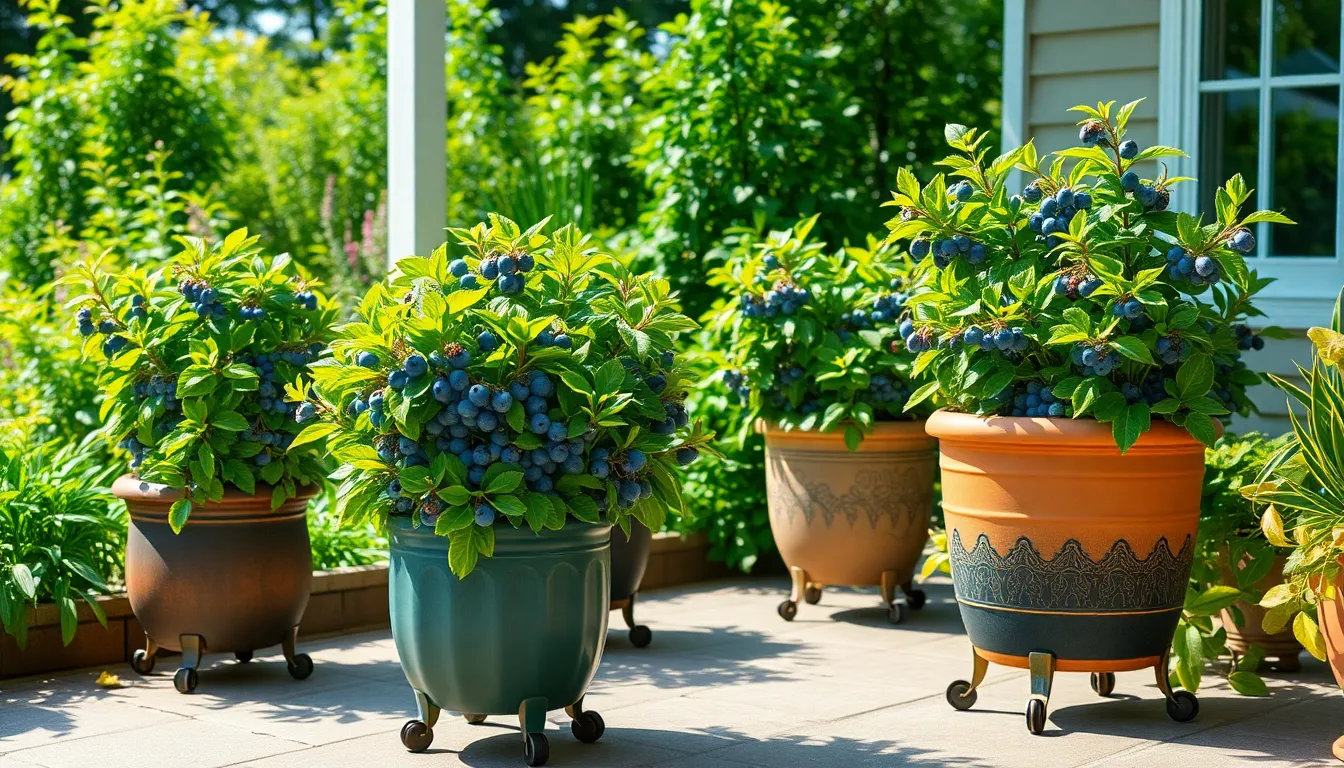
Once we’ve established our blueberry plants in their containers, creating the right environmental conditions becomes crucial for healthy growth and abundant fruit production.
Sunlight Requirements
Blueberry plants demand 6 to 8 hours of full sunlight daily to reach their maximum potential for growth and berry production. Position your containers in the sunniest spots available, such as south-facing patios or deck areas that receive consistent morning and midday sun.
Rolling casters attached to large pots make it easier to move containers throughout the day to follow optimal sunlight patterns. We recommend this approach especially for gardeners with limited sunny spaces or those dealing with shade from buildings or trees.
Afternoon shade becomes beneficial in very hot regions where temperatures regularly exceed 85°F during summer months. Place containers where they’ll receive morning sun but protection from intense afternoon heat, or use shade cloth to filter harsh rays while maintaining adequate light levels.
Temperature Considerations
Blueberries tolerate moderate climates best but can adapt to various temperature ranges with proper container management. Pots heat up much faster than ground soil, creating potential stress for root systems during hot weather.
Protection from extreme heat requires strategic positioning and sometimes additional measures like wrapping containers in light-colored materials or placing them in partially shaded areas during heat waves. We’ve found that containers can reach temperatures 10-15°F higher than surrounding air temperatures on sunny days.
Moving pots indoors or to protected areas during winter prevents root damage from freezing temperatures in colder climates. Unheated garages, cold frames, or even wrapping containers with insulating materials help maintain root zone temperatures above critical freezing points.
Root damage occurs when container soil freezes solid for extended periods, unlike ground-planted blueberries that benefit from earth’s natural insulation.
Air Circulation Needs
Good air circulation prevents fungal diseases and promotes overall plant health by maintaining balanced humidity levels around foliage and reducing moisture buildup on leaves. Position containers with adequate spacing between plants and away from walls or corners where air becomes stagnant.
Avoid exposing plants to strong, drying winds that can stress the plant and increase water needs dramatically. We recommend finding locations that offer gentle breezes without harsh, constant wind exposure that can damage branches or dry out soil too quickly.
Balanced humidity reduction occurs naturally with proper air movement, helping prevent common issues like powdery mildew and leaf spot diseases that thrive in still, humid conditions around container plants.
Master the Watering Schedule for Container Blueberries
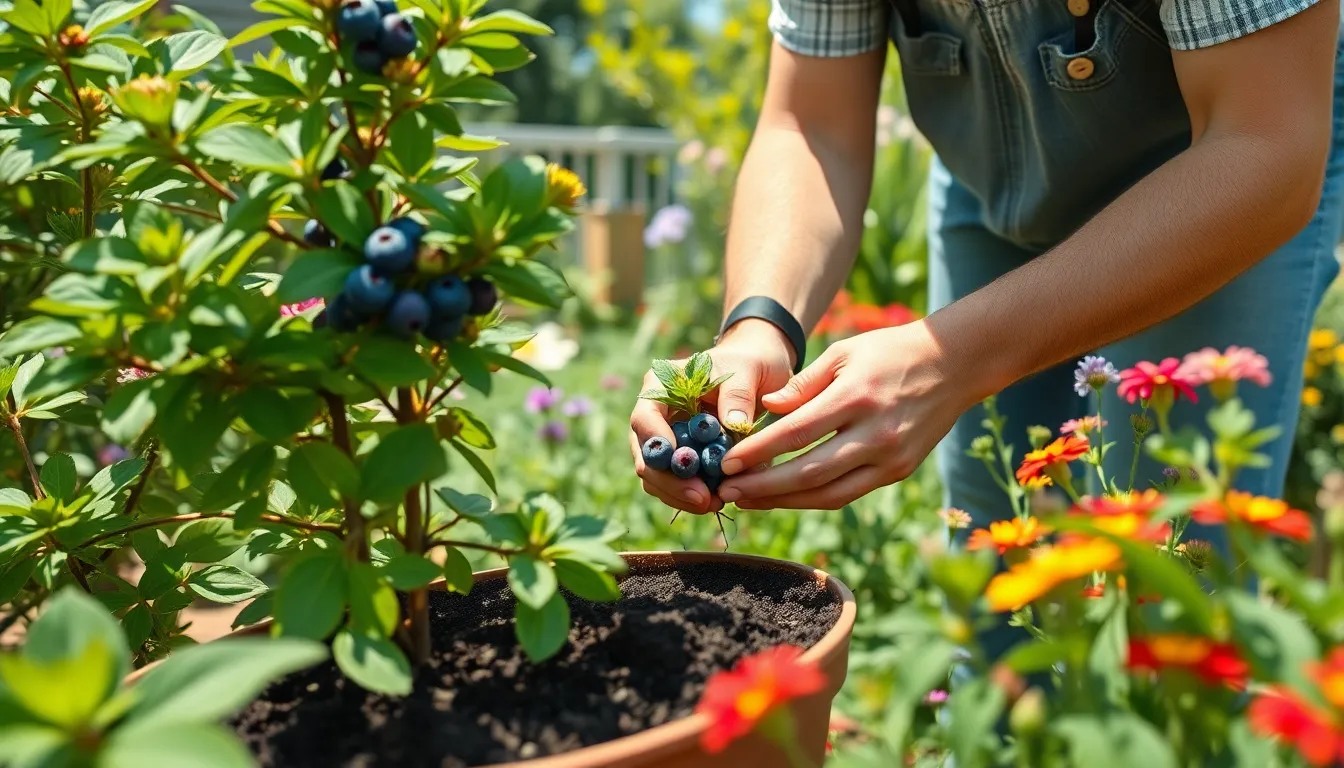
Container blueberries need consistent moisture to thrive and produce abundant fruit. Daily watering becomes essential during warm weather since potted plants dry out much faster than ground-planted varieties.
Moisture Level Monitoring
Check the top few inches of soil daily to determine when your blueberry plants need water. If the surface feels dry to touch, it’s time to provide moisture to maintain optimal growing conditions.
Maintain consistently moist soil without creating waterlogged conditions that can lead to root rot. Container blueberries perform best when their roots stay hydrated but never sit in standing water.
Watch for hydrophobic soil conditions that can develop when peat moss-based potting mixes become completely dry. Dried peat becomes difficult to rewet, making regular moisture monitoring critical for plant health.
Test soil moisture by inserting your finger 2-3 inches deep into the potting mix around the plant’s base. The soil should feel slightly damp throughout this depth range.
Seasonal Watering Adjustments
Increase watering frequency during hot, dry periods when container plants lose moisture rapidly through evaporation. Summer conditions often require daily watering to prevent plant stress.
Reduce watering schedules during cooler seasons and rainy periods to avoid oversaturating the root zone. Fall and winter typically need less frequent moisture applications.
Provide 1 to 2 inches of water weekly as a general guideline, but containers usually require more frequent applications than this amount suggests. Monitor individual plant needs rather than following rigid schedules.
Adjust for climate variations in your exact growing zone, as humidity levels and temperature fluctuations directly impact water requirements. Desert climates need more frequent watering than coastal regions.
Mulching for Water Retention
Apply organic mulch around your potted blueberry plants to reduce water evaporation from soil surfaces. This practice helps maintain steady moisture levels between watering sessions.
Choose acidic mulching materials like pine bark, pine needles, or wood chips that complement blueberries’ pH preferences. These organic options also break down slowly to improve soil structure over time.
Spread mulch 2-3 inches thick around the plant base while keeping material away from direct contact with the stem. Proper mulching reduces watering frequency by 30-40% during growing season.
Replace mulch annually to maintain its water retention properties and continue providing soil temperature regulation benefits. Fresh mulch also helps suppress weeds that compete for moisture.
Feed Your Blueberry Plants in Pots Regularly
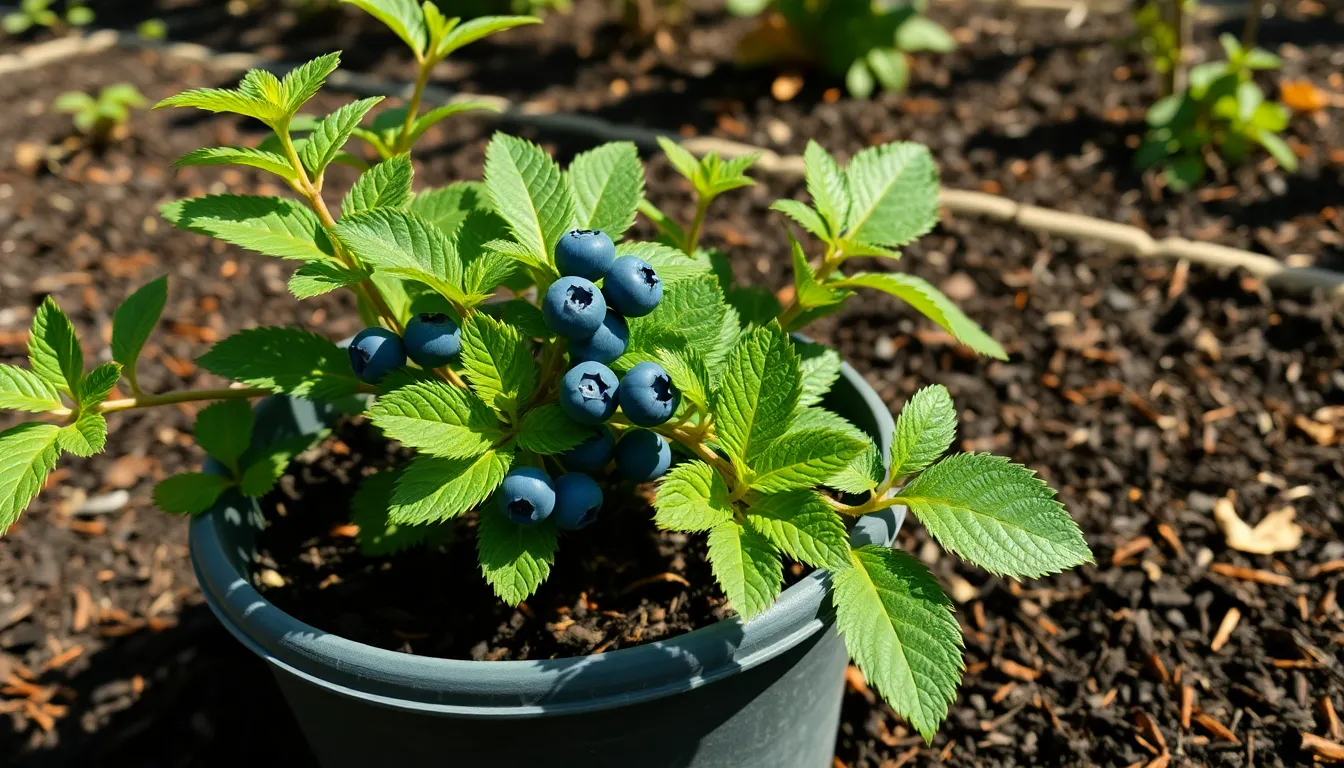
Container grown blueberries need consistent nutrition to thrive since they can’t access the wide root system of ground planted bushes. We recommend starting fertilizer applications 3 to 4 weeks after planting your blueberry bush in its new container.
Acid-Loving Plant Fertilizers
Blueberry plants require acidic soil conditions with a pH between 4 and 5.5 to absorb nutrients effectively. We suggest using fertilizers specifically labeled for acid loving plants, particularly those with balanced but low NPK numbers like 7-7-7 or 4-3-3. These specialized fertilizers maintain the acidic environment your blueberries crave while supplying essential nutrients without damaging the delicate root system.
Apply 1 to 2 ounces of acidifying fertilizer in a 15 to 18 inch circle around your plant, lightly scratch it into the soil surface, and water thoroughly. This feeding pattern should be repeated every 4 to 6 weeks during the growing season, especially during the first two years when establishing strong growth is crucial.
Organic vs Synthetic Options
Organic fertilizers offer important advantages for container blueberry growing compared to synthetic alternatives. Coffee grounds, pine bark, blood meal, cottonseed meal, fish emulsion, and seaweed extracts release nutrients slowly, matching the natural growth rate of blueberry plants and reducing the risk of nutrient burn.
We’ve found that organic options enhance soil structure within the limited pot environment while increasing beneficial microbial activity. This approach builds soil organic matter over time, leading to healthier plants, bigger berries, and fewer disease problems. Organic fertilizers also prevent salt buildup that commonly occurs with synthetic fertilizers in containers.
Synthetic fertilizers provide quicker nutrient availability and faster initial growth, but they increase risks of root burn and can negatively impact soil health when overused. Container environments are particularly sensitive to synthetic fertilizer accumulation since excess salts have nowhere to leach away.
Feeding Schedule Throughout the Year
Year of Planting: Start your feeding program 3 to 4 weeks after transplanting with the recommended 1 to 2 ounce applications every 4 to 6 weeks throughout the growing season.
Second Year: Apply fertilizer twice in spring, with the first application in April and the second dose 4 to 6 weeks later, scratching it into the soil and watering well.
Ongoing Years: Fertilize in early spring when new growth begins, apply a second feeding 6 weeks later, and provide a post harvest application to replenish nutrients for the next growing cycle.
| Timing | Application | Amount | Method |
|---|---|---|---|
| 3-4 weeks after planting | Initial feeding | 1-2 ounces | Circle around plant, scratch in |
| Every 4-6 weeks | Growing season | 1-2 ounces | Same method, water thoroughly |
| Early spring | Annual start | 1-2 ounces | Scratch into soil surface |
| 6 weeks later | Mid season | 1-2 ounces | Apply around drip line |
| Post harvest | Recovery feeding | 1-2 ounces | Prepare for next season |
Adjust feeding frequency and amounts based on your plant’s response and consider soil testing when possible to fine tune your nutrition program. Regular watering and organic mulching complement your fertilization efforts to maintain healthy, productive blueberry plants in containers.
Prune and Maintain Your Container Blueberry Plants
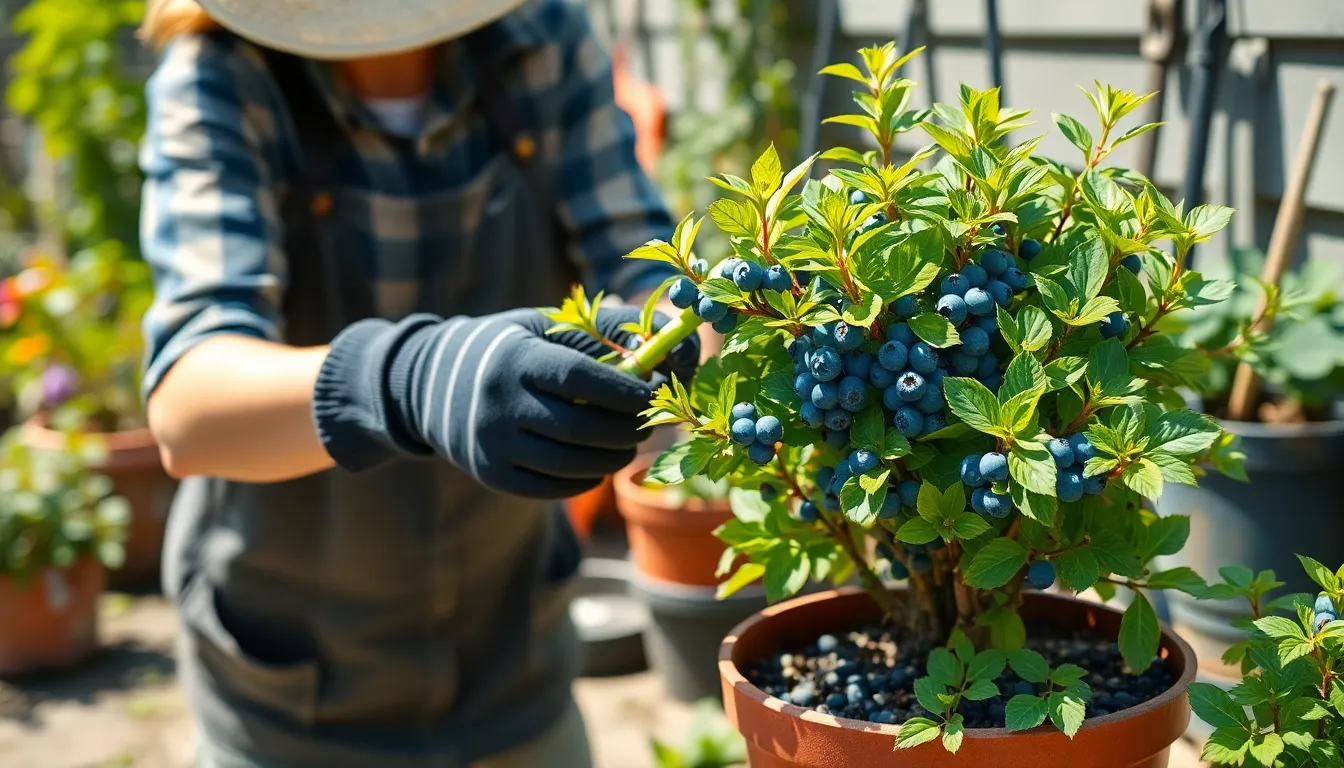
Proper pruning and maintenance keep our container blueberries healthy and productive for years to come. Regular care ensures strong growth and maximizes our berry harvest.
Annual Pruning Techniques
Annual pruning maintains plant health and improves fruit quality while encouraging vigorous new growth. We recommend pruning in late winter or early spring before new growth begins, giving our plants the best start for the growing season.
Remove dead, damaged, or weak branches first to eliminate potential disease sources. Thin out crowded areas next to improve air circulation throughout the plant. We should focus on maintaining an open shape that allows sunlight to reach all parts of the bush.
Older branches need removal to stimulate fresh growth since blueberries produce most fruit on younger canes. Cut back branches that are more than 4 to 6 years old at the base. This practice redirects the plant’s energy into developing productive new shoots.
Dead-Heading Spent Flowers
Dead-heading prevents our plants from wasting energy on seed production after blooming finishes. We remove spent flowers by pinching or cutting them off once petals fall and before berries begin forming.
This technique encourages our blueberry plants to focus energy on developing stronger root systems and healthier shoots. Better root development leads to improved nutrient uptake and stronger overall plant structure. We’ll see the benefits in the following season with increased berry yields and plant vigor.
Timing matters when dead-heading our container blueberries. We should check plants weekly during the blooming period and remove faded flowers promptly. Regular monitoring ensures we catch spent blooms before the plant invests energy in seed development.
Shape and Size Management
Container blueberry plants require regular shaping to control their size and fit properly in pots. We maintain balanced growth by trimming overly long branches and keeping a roughly upright, bushy shape that suits container growing.
Size control prevents overcrowding in our containers, which can lead to poor air circulation and disease problems. Trim branches that extend beyond the desired shape or grow too close to other branches. We want to maintain adequate spacing between major branches.
Air circulation improves when we shape our plants properly, reducing the risk of fungal diseases that thrive in humid, crowded conditions. Keep the center of the plant relatively open by removing some interior branches. This management technique also makes harvesting easier and more efficient.
Regular maintenance throughout the growing season helps us catch problems early. We should inspect our container blueberries monthly for signs of disease, pest damage, or structural issues that need attention.
Protect Your Potted Blueberry Plants from Pests and Diseases

Container grown blueberries face unique challenges that require proactive management to maintain healthy plants and maximize fruit production. We’ll explore the most effective strategies to keep your potted blueberry bushes thriving throughout the growing season.
Common Container Growing Issues
Watering problems top the list of container growing challenges for blueberry plants. Shallow root systems dry out quickly in pots, requiring daily moisture checks and consistent watering to maintain the preferred moist but not soggy soil conditions. Containers dry faster than ground soil, making daily watering necessary during warm weather periods.
Soil acidity imbalances create serious nutrient uptake problems for potted blueberries. These plants require acidic soil with a pH between 4.0 and 4.8 for proper nutrient absorption, and container soils can shift pH levels more rapidly than garden beds.
Temperature and humidity fluctuations stress containerized plants more than ground planted varieties. Pots should be positioned in sheltered locations during cold, dry winter winds to prevent damage and maintain plant health.
Root space limitations restrict growth when containers become too small for developing root systems. Large enough pots prevent root binding and support proper plant development throughout the growing season.
Sunlight exposure challenges arise when containers can’t be moved to maintain the required 6 to 8 hours of daily sunlight. Fixed container positions may limit optimal light exposure as seasons change.
Organic Treatment Options
Neem oil and insecticidal soaps effectively manage soft bodied pests like aphids and spider mites without harmful chemical residues. Apply these treatments during cooler parts of the day to prevent leaf burn and maximize effectiveness.
Horticultural oils smother pest eggs and adult insects while remaining safe for beneficial insects when applied correctly. Timing applications during pest life cycles increases control success rates.
Organic fungicides containing copper or sulfur help control fungal diseases that thrive in container environments. Regular applications during humid conditions provide preventive protection against common fungal issues.
Compost tea applications improve soil health and boost plant resistance to diseases naturally. Weekly applications during the growing season strengthen plant immune systems and promote beneficial soil microorganisms.
Beneficial insect encouragement creates natural pest control through ladybugs, lacewings, and other predatory species. Plant companion flowers nearby to attract these helpful insects to your container garden area.
Prevention Strategies
Water management practices form the foundation of disease prevention in container blueberries. Check soil moisture regularly and apply mulch with pine bark or organic compost to retain consistent moisture levels while preventing waterlogged conditions.
Air circulation positioning reduces humidity buildup around plants that encourages fungal growth. Space containers adequately and position them where natural airflow reaches all plant surfaces throughout the day.
Sanitation routines eliminate pest and disease breeding grounds through regular cleanup. Remove fallen leaves and dropped fruit immediately to prevent problem buildup around container bases.
Annual pruning schedules improve plant vigor and airflow by removing dead or weak branches each dormant season. Proper pruning timing and techniques strengthen plants against pest and disease pressure.
Winter protection measures shield containers from harsh weather that weakens plant defenses. Move pots to sheltered areas during extreme cold periods to protect roots from freezing damage.
Soil testing programs maintain proper pH levels through periodic monitoring and amendment applications. Test soil acidity twice yearly and adjust with appropriate acidifying materials as needed.
Harvest and Store Your Homegrown Blueberries
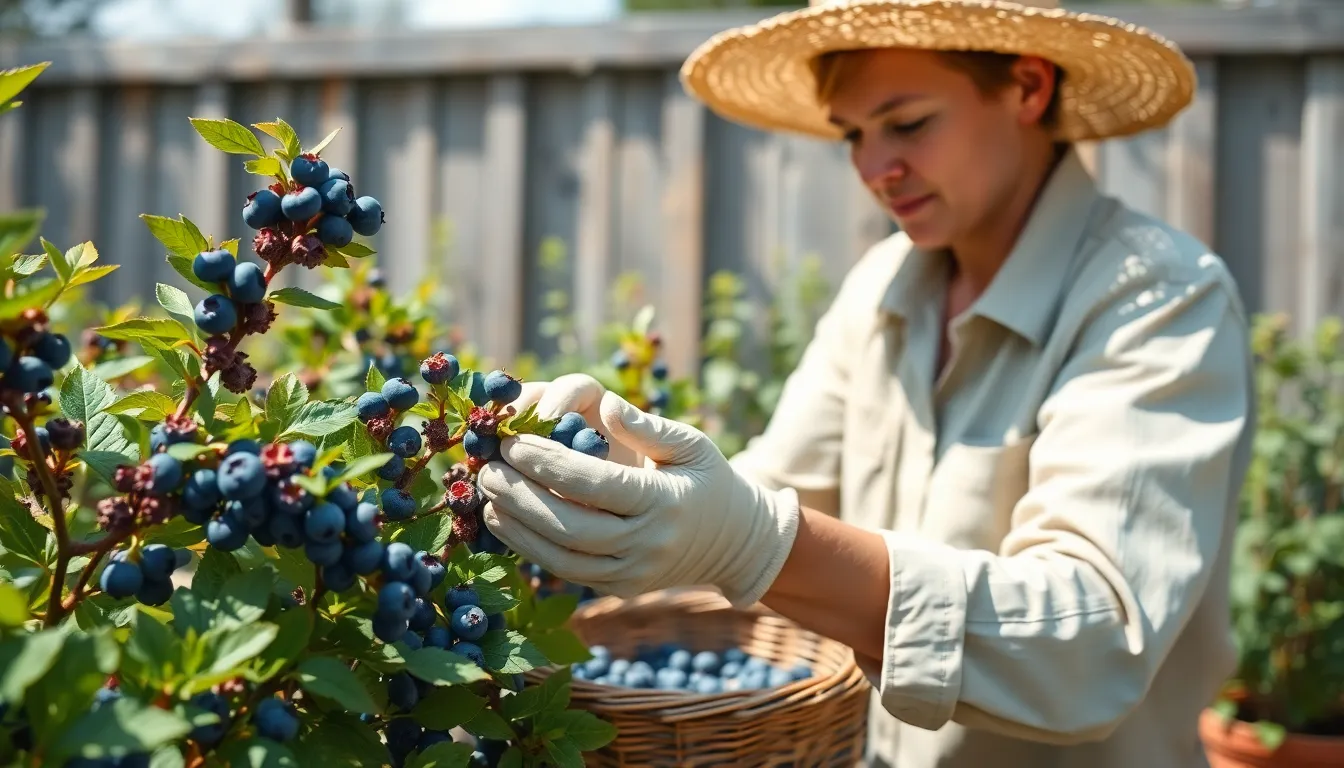
After months of careful tending to your potted blueberry plants, the moment you’ve been waiting for has arrived. Let’s explore how to determine peak ripeness and preserve your homegrown bounty.
Ripeness Indicators
Uniform deep blue color signals that your blueberries are ready for harvest. We look for berries with no green or red tints, as these indicate the fruit hasn’t reached full maturity yet.
Plump appearance becomes evident when berries have developed their full size and sweetness. Touch the berries gently to check for slight softness, which indicates optimal ripeness.
Easy stem separation occurs naturally when berries are perfectly ripe. Gently tug on individual berries, and they should detach effortlessly from the stem without resistance.
Sweet aroma develops as blueberries reach peak ripeness. We notice that fully mature berries emit a subtle, pleasant fragrance that’s distinctly different from unripe fruit.
Proper Picking Techniques
Gentle rolling motion works best when harvesting your container blueberries. We recommend using your thumb and forefinger to roll ripe berries off the stem rather than pulling them forcefully.
Regular picking schedule encourages continuous fruit production throughout the growing season. Visit your potted plants every 2 to 3 days to collect newly ripened berries and maintain plant productivity.
Dry berry harvesting reduces the risk of mold development during storage. We avoid picking berries when they’re wet from rain or morning dew, as moisture can lead to faster spoilage.
Selective harvesting ensures you’re only collecting fully ripe fruit. Focus on berries that meet all ripeness indicators rather than harvesting entire clusters at once.
Storage Methods for Fresh Berries
Immediate refrigeration extends the shelf life of your freshly picked blueberries significantly. We place harvested berries in shallow containers with good air circulation and refrigerate them right away.
| Storage Method | Duration | Temperature | Container Type |
|---|---|---|---|
| Refrigerated | 1-2 weeks | 32-35°F | Shallow containers |
| Frozen | 8-12 months | 0°F | Sealed bags/containers |
| Room temperature | 2-3 days | 65-70°F | Breathable containers |
Proper container selection prevents berry damage and promotes air circulation. We use shallow dishes or perforated containers rather than deep bowls that can crush berries at the bottom.
Freezing preparation involves spreading berries on baking sheets before transferring to permanent storage. This flash freezing technique prevents berries from clumping together in freezer bags or containers.
Moisture management keeps stored berries fresh longer by avoiding excess humidity. We store berries dry and unwashed until ready to consume, as washing before storage can accelerate spoilage.
Conclusion
Growing blueberries in containers opens up endless possibilities for gardeners of all skill levels. We’ve shown you that with the right varieties proper soil preparation and consistent care you can enjoy fresh organic berries regardless of your space limitations.
The journey from selecting the perfect pot to harvesting your first sweet blueberries is incredibly rewarding. Remember that success comes from attention to detail – maintaining acidic soil monitoring moisture levels and providing adequate sunlight are your keys to thriving plants.
Your container blueberry garden will provide years of delicious harvests while adding beauty to your outdoor space. With the knowledge you’ve gained you’re ready to start your own blueberry growing adventure and enjoy the satisfaction of homegrown fruit right at your doorstep.
Frequently Asked Questions
Can I grow blueberries in containers if I have limited space?
Yes, blueberries are excellent for container gardening! They’re perfect for small spaces, patios, or balconies. Container growing gives you better control over soil conditions, drainage, and protection from pests. You can even move the containers to optimize sunlight exposure throughout the day.
What size pot do I need for blueberry plants?
For mature blueberry plants, use containers at least 24 inches deep and 24-30 inches wide. Smaller dwarf varieties can thrive in slightly smaller pots. Ensure your container has ample drainage holes and avoid black pots that absorb too much heat.
What type of soil do blueberries need in containers?
Blueberries require highly acidic soil with a pH between 4.5 and 5.5. Use a mix containing peat moss and pine bark as key components, plus perlite or coarse sand for drainage. Regular potting soil is too alkaline for blueberries.
Which blueberry varieties work best in containers?
Dwarf and compact varieties like Top Shelf, Sunshine Blue, Northsky, and Patriot are ideal for containers. Choose varieties that match your climate zone and consider whether you want self-pollinating or cross-pollinating types for maximum berry production.
How often should I water container blueberries?
Check soil moisture daily and water when the top inch feels dry. Increase watering frequency during hot weather and reduce in cooler seasons. Maintain consistent moisture but avoid waterlogged soil. Mulching helps retain moisture and maintain soil acidity.
What fertilizer should I use for container blueberries?
Use acid-loving fertilizers specifically designed for blueberries. Start feeding 3-4 weeks after planting and follow a regular schedule. Organic fertilizers are preferred over synthetic options for better long-term soil health and plant development.
When and how should I prune container blueberries?
Prune annually in late winter or early spring before new growth begins. Remove dead, weak, or crossing branches to improve air circulation. Dead-head spent flowers to redirect energy toward root development and overall plant vigor.
How do I know when blueberries are ready to harvest?
Ripe blueberries have a uniform deep blue color, plump appearance, and easily separate from the stem with gentle rolling motion. They should have a sweet aroma and feel slightly soft. Pick regularly to encourage continued fruit production.
Can container blueberries survive winter outdoors?
Yes, but they need protection in harsh climates. Insulate containers with burlap or move them to sheltered areas during extreme cold. Choose varieties suited to your hardiness zone and ensure proper drainage to prevent root damage from freezing.
What are common problems with container blueberries?
Common issues include watering problems, soil pH imbalances, temperature fluctuations, and limited root space. Prevent problems through proper water management, regular soil testing, adequate air circulation, and annual container upgrades as plants grow.

